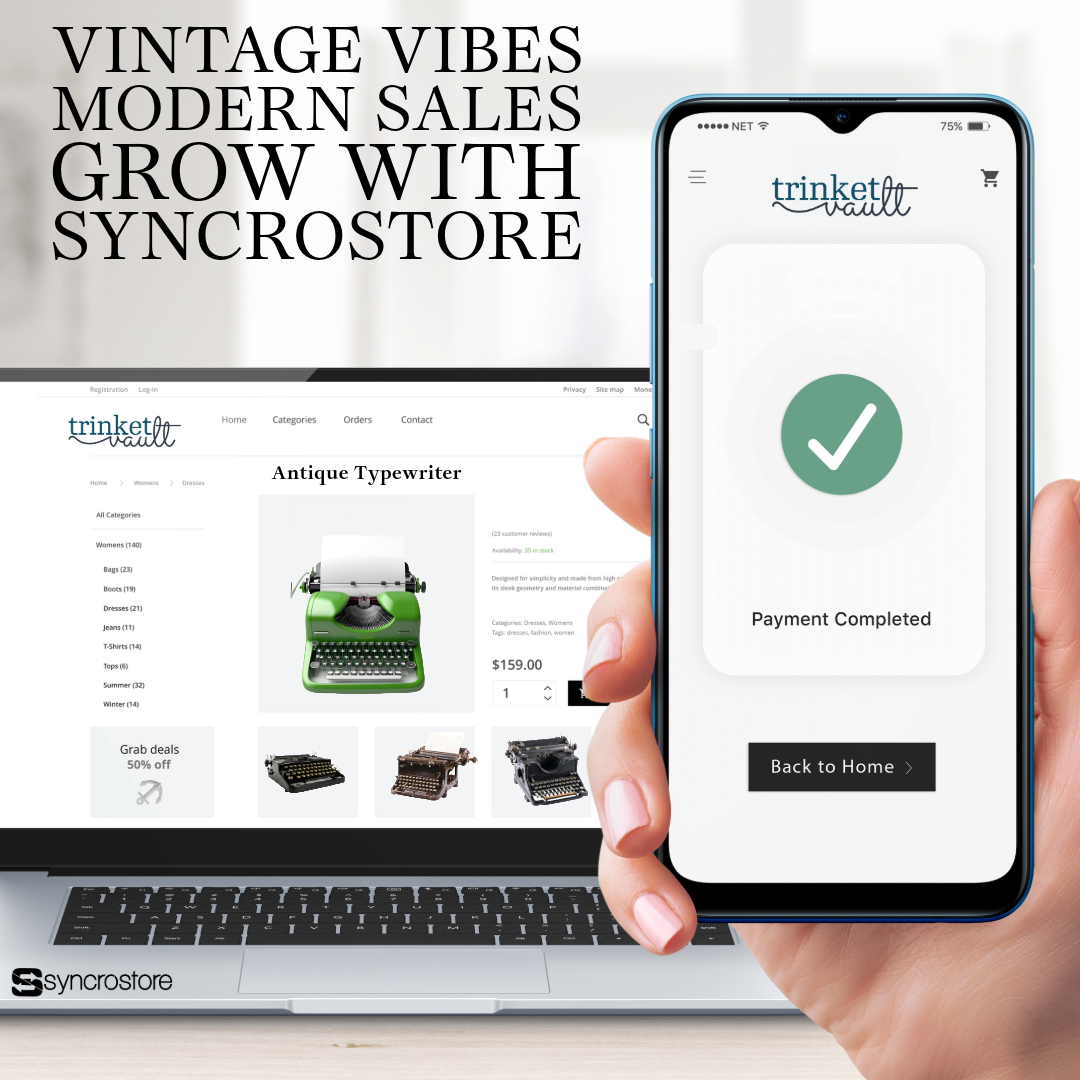The Importance of E-Commerce for Antique and Consignment Stores
In today’s digital age, antique and consignment stores face a unique opportunity to expand their reach and boost their business through e-commerce. While the charm of a physical store filled with vintage treasures or curated secondhand goods is undeniable, establishing an online presence is no longer optional, it’s essential. An e-commerce site not only drives sales by making products accessible to a global audience but also enhances visibility through search engine optimization (SEO), particularly for high-intent keywords like “antique store near me” and “consignment store near me.” Additionally, platforms like SyncroStore, with its seamless and free direct sync to TrinketVault, empower store owners to manage their inventory and grow their businesses efficiently within a single point-of-sale (POS) software suite. This blog post explores why e-commerce is a game-changer for antique and consignment stores, backed by data on sales increases, SEO benefits, and practical tools to make it happen.
Why E-Commerce Matters for Antique and Consignment Stores
Expanding Market Reach Beyond the Storefront
Antique and consignment stores traditionally rely on local foot traffic, but an e-commerce site breaks down geographic barriers. Customers from across the country—or even the world—can browse and purchase unique items like vintage furniture, rare collectibles, or designer consignment clothing. According to a 2023 report by Statista, global e-commerce retail sales are projected to reach $7 trillion by 2025, with the U.S. alone accounting for over $1.3 trillion. For niche markets like antiques and consignment, this growth signals a massive opportunity to tap into a broader customer base.
E-commerce allows stores to showcase their full inventory online, not just what fits in a physical display. This is particularly valuable for antique stores, where one-of-a-kind items like a mid-century modern chair or a Victorian-era lamp may appeal to collectors who aren’t local. Similarly, consignment stores can attract buyers looking for sustainable fashion or unique home goods, trends that have surged among millennials and Gen Z, with resale store sales increasing by over 50% between 2008 and 2016, per the U.S. Census Bureau.
Sales Increases Through E-Commerce: By the Numbers
An e-commerce presence can significantly boost sales for antique and consignment stores. While exact figures vary by category and implementation, studies and case studies provide compelling evidence of the potential. Below is a breakdown of estimated sales increases for popular antique and consignment categories, based on available data and industry trends:
- Antique Furniture: A 2020 study by eMarketer found that furniture e-commerce sales grew by 32% year-over-year, with antique furniture benefiting from the trend of consumers seeking unique, high-quality pieces online. Antique stores with e-commerce sites can expect a 20–35% sales increase by reaching collectors and interior designers who browse platforms like eBay, Etsy, or specialized marketplaces like TrinketVault.
- Vintage Collectibles (e.g., coins, stamps, memorabilia): Collectibles have seen a 25% increase in online sales, driven by niche marketplaces and auction sites, according to a 2021 IBISWorld report. Antique stores listing collectibles online can achieve a 15–30% sales boost, as collectors often search globally for rare items.
- Consignment Clothing and Accessories: The secondhand apparel market has exploded, with GlobalData noting that 18–37-year-olds are driving a 24% annual growth rate in resale clothing. Consignment stores with e-commerce platforms can see a 25–40% sales increase, especially for high-demand items like designer handbags or vintage dresses.
- Home Décor (e.g., vintage lamps, art, textiles): Home décor e-commerce sales grew by 28% in 2022, per Statista. For consignment and antique stores, listing décor items online can lead to a 15–25% sales uplift, as consumers seek unique pieces to personalize their spaces.
These figures are drawn from broader e-commerce trends and niche market analyses, as specific data for antique and consignment stores is limited. However, a case study by The HOTH demonstrated that an online fashion store (a comparable niche) achieved a 33.1k increase in organic traffic and a significant sales boost within six months through e-commerce SEO, suggesting similar potential for antiques and consignment.
Driving Business Through SEO and Local Search
An e-commerce site does more than facilitate online sales—it’s a powerful tool for driving both online and in-store business through SEO. When potential customers search for terms like “antique store near me” or “consignment store near me,” a well-optimized e-commerce site can rank highly, attracting local and non-local customers alike. Here’s how:
The Power of Local SEO
Local SEO is critical for antique and consignment stores, as 33% of clicks go to the top three search results on Google’s first page. Keywords like “antique store near me” (search volume: ~135,000/month in the U.S., per Google Keyword Planner) and “consignment store near me” (~22,000/month) are high-intent queries, meaning searchers are ready to visit or buy. Optimizing your e-commerce site for these terms involves:
- Google Business Profile Optimization: Claim and update your profile with accurate store details, high-quality images, and customer reviews. This boosts visibility in Google’s local pack and maps.
- Geo-Specific Keywords: Include your city or region in product descriptions, meta titles, and headers (e.g., “Vintage Furniture in Chicago”). This aligns with local search intent.
- Customer Reviews: Positive reviews on Google and other platforms enhance trust and rankings, with 72% of shoppers more likely to visit businesses with good reviews.
How Online Inventory Boosts SEO
Every item listed on your e-commerce site is an opportunity to rank for relevant keywords. For example, a product page for a “mid-century teak dining table” can be optimized for long-tail keywords like “mid-century teak dining table for sale” (low competition, high conversion). Long-tail keywords account for over 90% of searches and have higher conversion rates due to their specificity. By creating detailed product descriptions, using alt text for images, and incorporating schema markup, your site becomes more discoverable.
Structured data, such as schema markup for products, can increase organic search rankings by up to 30%. For antique stores, this means tagging items with details like price, condition, and availability to appear in rich snippets. Consignment stores can optimize for keywords like “used designer handbags” or “vintage clothing [city],” which are less competitive but highly targeted.
Case Study: SEO Success in Action
A 2025 case study by The HOTH highlighted an online store that increased organic traffic by 33.1k in six months through e-commerce SEO. By optimizing product pages for transactional keywords (e.g., “buy vintage sneakers”) and building high-quality backlinks, the store saw a surge in sales. Antique and consignment stores can replicate this by listing inventory online and targeting niche keywords like “antique jewelry [city]” or “consignment furniture near me.”
Challenges of E-Commerce for Antique and Consignment Stores
While the benefits are clear, setting up and managing an e-commerce site can be daunting. Common challenges include:
- Inventory Management: Keeping online and in-store inventory synced is complex, especially for one-of-a-kind items.
- Technical SEO: Ensuring fast load times, mobile-friendliness, and proper site architecture requires expertise.
- Content Creation: Writing unique, keyword-rich product descriptions for hundreds of items is time-consuming.
- Competition: Standing out in a crowded online marketplace requires strategic SEO and marketing.
This is where Syncrostore comes in, offering a comprehensive solution tailored to antique and consignment stores.
Syncrostore: Your All-in-One E-Commerce Solution
Syncrostore is a powerful POS software suite designed to simplify e-commerce for antique and consignment stores. Its standout feature is a free direct sync to TrinketVault, a marketplace for vintage and collectible items, allowing store owners to list products on a specialized platform without additional costs. Here’s how Syncrostore helps:
- Seamless Inventory Management: SyncroStore syncs your physical and online inventory in real-time, preventing overselling and streamlining operations.
- TrinketVault Integration: With the free sync, your products automatically appear on TrinketVault, exposing them to a targeted audience of antique and vintage enthusiasts.
- Built-In SEO Tools: Syncrostore optimizes product listings with keyword suggestions, meta tags, and schema markup to boost search rankings.
- User-Friendly Interface: No technical expertise is needed to create professional product pages with high-quality images and descriptions.
- Analytics and Insights: Track online and in-store sales, monitor keyword performance, and identify top-performing categories.
By consolidating POS, e-commerce, and marketplace integration into one platform, SyncroStore saves time and maximizes revenue. Whether you’re selling a rare coin or a consigned designer dress, Syncrostore ensures your items reach the right buyers—both locally and globally.
Final Thoughts
An e-commerce site is a must-have for antique and consignment stores looking to thrive in 2025 and beyond. By enabling online sales, stores can achieve significant revenue growth—up to 35% for furniture, 30% for collectibles, 40% for consignment clothing, and 25% for home décor—while reaching a global audience. Simultaneously, a well-optimized site boosts SEO, capturing high-intent searches like “antique store near me” and driving both online and in-store traffic. With Syncrostore and its free TrinketVault sync, store owners can streamline operations, enhance visibility, and grow their businesses effortlessly. Don’t let outdated systems hold you back—embrace e-commerce and watch your antique or consignment store flourish.
Sources: Statista, eMarketer, IBISWorld, GlobalData, The HOTH, U.S. Census Bureau



